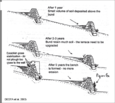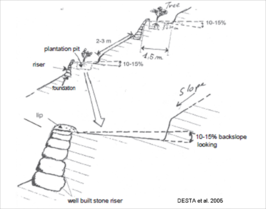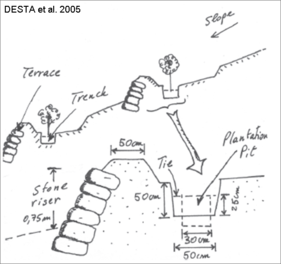Difference between revisions of "Micro-hydro Power (MHP) Projects - Mitigation and Intervention Techniques - Physical Soil and Water Conservation"
From energypedia
***** (***** | *****) (Created page with " = Overview<br/> = ► Back to the overview "[[Mitigation and Intervention Techniques Related to Micro-hydro Power (MHP) Projects|Mitigation and Intervention Techniques Relate...") |
***** (***** | *****) |
||
| (2 intermediate revisions by 2 users not shown) | |||
| Line 10: | Line 10: | ||
=== Level Soil Bunds === | === Level Soil Bunds === | ||
| − | {| | + | {| style="width: 100%;" border="1" cellspacing="1" cellpadding="1" |
|- | |- | ||
| − | | style="width: 506px" | <u>Objectives</u>: The bund '''reduces and stops the velocity of runoff and consequently reduces soil erosion and the steady decline of crop yields'''. They are impermeable structures, unless provided with spillways, intended to retain all rainfall, and hence, increase the moisture retention capacity of the soil profile and water availability to plants, and increase the efficiency of fertilizer applications if any. Through their water retention effect, the bunds may allow some crop yield even in drought years. Soil bunds are entry points for further stabilisation and application of organic residues or compost (especially if applied in the first meters behind the bund where soil is deeper). | + | | style="width: 506px;" | <u>Objectives</u>: The bund '''reduces and stops the velocity of runoff and consequently reduces soil erosion and the steady decline of crop yields'''. They are impermeable structures, unless provided with spillways, intended to retain all rainfall, and hence, increase the moisture retention capacity of the soil profile and water availability to plants, and increase the efficiency of fertilizer applications if any. Through their water retention effect, the bunds may allow some crop yield even in drought years. Soil bunds are entry points for further stabilisation and application of organic residues or compost (especially if applied in the first meters behind the bund where soil is deeper). |
| − | | style="width: 242px" | <br/> | + | | style="width: 242px;" | <br/> |
|} | |} | ||
| − | |||
| − | |||
| − | |||
=== Stone Bunds === | === Stone Bunds === | ||
| − | {| | + | {| style="width: 100%;" border="1" cellspacing="1" cellpadding="1" |
|- | |- | ||
| − | | style="width: 522px" | <u>Objectives</u>: The stone bund '''reduces and stops the velocity of runoff and consequently reduces soil erosion and the steady decline in fertility and crop yields'''. They are semi-permeable structures unless sealed with soil in their upper side. They increase the moisture retention capacity of the soil profile and water availability to plants, and increase the efficiency of fertilizer applications if any. Through their water retention effect the stone bunds may allow some crop yield even in drought years. Stone bunds are entry points for application of organic residues or compost, especially in the first 2-3 meters behind the bund where soil is deeper. | + | | style="width: 522px;" | <u>Objectives</u>: The stone bund '''reduces and stops the velocity of runoff and consequently reduces soil erosion and the steady decline in fertility and crop yields'''. They are semi-permeable structures unless sealed with soil in their upper side. They increase the moisture retention capacity of the soil profile and water availability to plants, and increase the efficiency of fertilizer applications if any. Through their water retention effect the stone bunds may allow some crop yield even in drought years. Stone bunds are entry points for application of organic residues or compost, especially in the first 2-3 meters behind the bund where soil is deeper. |
| − | | style="width: 226px" | [[File:StoneBunds.png|thumb|left|115px|Stone Bunds|alt=StoneBunds.png]] | + | | style="width: 226px;" | [[File:StoneBunds.png|thumb|left|115px|Stone Bunds|alt=StoneBunds.png]] |
|} | |} | ||
| − | |||
| − | |||
| − | |||
=== Stone Faced Soil Bunds === | === Stone Faced Soil Bunds === | ||
| − | {| | + | {| style="width: 100%;" border="1" cellspacing="1" cellpadding="1" |
|- | |- | ||
| − | | style="width: 534px" | | + | | style="width: 534px;" | |
*<u>Objectives</u>: The stone faced bunds are reinforced soil bunds in one or both their sides. It has the same objectives of soil and stone bunds. Provided they are well constructed stone faced soil bunds<br/>offer strong resistance against runoff. Stone faced bunds are suitable in areas with high stoniness and stable soils, combined with trenches and vegetative stabilization. Suitable for dry areas and combined with other moisture conservation measures like tie-ridging and compost applications above bund or benched area.<br/> | *<u>Objectives</u>: The stone faced bunds are reinforced soil bunds in one or both their sides. It has the same objectives of soil and stone bunds. Provided they are well constructed stone faced soil bunds<br/>offer strong resistance against runoff. Stone faced bunds are suitable in areas with high stoniness and stable soils, combined with trenches and vegetative stabilization. Suitable for dry areas and combined with other moisture conservation measures like tie-ridging and compost applications above bund or benched area.<br/> | ||
| − | | style="width: 214px" | <br/> | + | | style="width: 214px;" | <br/> |
|} | |} | ||
<br/> | <br/> | ||
| Line 41: | Line 35: | ||
=== Level Fanya Juu === | === Level Fanya Juu === | ||
| − | {| | + | {| style="width: 100%;" border="1" cellspacing="1" cellpadding="1" |
|- | |- | ||
| − | | style="width: 533px" | | + | | style="width: 533px;" | |
*<u>Objectives</u>: The FJ '''reduces and stops the velocity of runoff and consequently reduces soil erosion and the steady decline of crop yields'''. They are impermeable structures intended to retain rainfall, and hence, increase s.oil moisture, water availability to plants, and increase the efficiency of fertilizer application if any. Fanya juus bench quicker than soil bunds but are not as efficient in moisture conservation and more prone to breakages/overtopping.<br/> | *<u>Objectives</u>: The FJ '''reduces and stops the velocity of runoff and consequently reduces soil erosion and the steady decline of crop yields'''. They are impermeable structures intended to retain rainfall, and hence, increase s.oil moisture, water availability to plants, and increase the efficiency of fertilizer application if any. Fanya juus bench quicker than soil bunds but are not as efficient in moisture conservation and more prone to breakages/overtopping.<br/> | ||
| − | | style="width: 215px" | [[File:FanyaJuuBund.png|thumb|left|200px|Fanya Juu Bund|alt=FanyaJuuBund.png]] | + | | style="width: 215px;" | [[File:FanyaJuuBund.png|thumb|left|200px|Fanya Juu Bund|alt=FanyaJuuBund.png]] |
|} | |} | ||
<br/> | <br/> | ||
| Line 52: | Line 46: | ||
=== Bench Terracing<br/> === | === Bench Terracing<br/> === | ||
| − | {| | + | {| style="width: 100%;" border="1" cellspacing="1" cellpadding="1" |
|- | |- | ||
| − | | style="width: 542px" | | + | | style="width: 542px;" | |
*<u>Objectives</u>: The terrace in most cases converts a steep slope into a series of steps, with nearly horizonal benches to '''reduce velocity of runoff, reduce the soil erosion and the decline in crop yields'''.<br/> | *<u>Objectives</u>: The terrace in most cases converts a steep slope into a series of steps, with nearly horizonal benches to '''reduce velocity of runoff, reduce the soil erosion and the decline in crop yields'''.<br/> | ||
| − | | style="width: 206px" | <br/> | + | | style="width: 206px;" | <br/> |
|} | |} | ||
<br/> | <br/> | ||
| Line 63: | Line 57: | ||
=== Conservation Tillage using Maresha and Broad Bed and Farrows Maker (BBM) === | === Conservation Tillage using Maresha and Broad Bed and Farrows Maker (BBM) === | ||
| − | {| | + | {| style="width: 100%;" border="1" cellspacing="1" cellpadding="1" |
|- | |- | ||
| − | | style="width: 572px" | | + | | style="width: 572px;" | |
*<u>Objectives</u>: Undisturbed soil that is permanently protected by vegetative cover improves in the manner that occur in the native ecosystems,including maintenance of porous and soft soil layers through litter accumulation, intense biological activity, movement of soil fauna, and root growth. These functions improve efficient water, heat, and gas transfers within the entire soil profile. The presence of crop residues on the soil surface '''minimizes soil evaporation, and in regions of low rainfall can conserve water and increase crop water use efficiency thus improving crop yields'''.<br/> | *<u>Objectives</u>: Undisturbed soil that is permanently protected by vegetative cover improves in the manner that occur in the native ecosystems,including maintenance of porous and soft soil layers through litter accumulation, intense biological activity, movement of soil fauna, and root growth. These functions improve efficient water, heat, and gas transfers within the entire soil profile. The presence of crop residues on the soil surface '''minimizes soil evaporation, and in regions of low rainfall can conserve water and increase crop water use efficiency thus improving crop yields'''.<br/> | ||
| − | | style="width: 176px" | <br/> | + | | style="width: 176px;" | <br/> |
|} | |} | ||
<br/> | <br/> | ||
| Line 74: | Line 68: | ||
=== Hillside Terraces === | === Hillside Terraces === | ||
| − | {| | + | {| style="width: 100%;" border="1" cellspacing="1" cellpadding="1" |
|- | |- | ||
| − | | style="width: 556px" | | + | | style="width: 556px;" | |
*<u>Objectives</u>: Hillside terraces are physical structures constructed along the contours, generally suitable in steep degraded slopes and shallow soils (although common in other type of soils), suitable for tree planting and rather effective in '''controlling runoff and erosion'''. Common in most parts of Ethiopia, generally in dry areas to support area closure plantation and protect downstream fields.<br/> | *<u>Objectives</u>: Hillside terraces are physical structures constructed along the contours, generally suitable in steep degraded slopes and shallow soils (although common in other type of soils), suitable for tree planting and rather effective in '''controlling runoff and erosion'''. Common in most parts of Ethiopia, generally in dry areas to support area closure plantation and protect downstream fields.<br/> | ||
| − | | style="width: 192px" | [[File:HillsideTerraces.png|thumb|left|266px|Hillside Terraces|alt=HillsideTerraces.png]] | + | | style="width: 192px;" | [[File:HillsideTerraces.png|thumb|left|266px|Hillside Terraces|alt=HillsideTerraces.png]] |
|} | |} | ||
| − | + | === Hillside Terrace with Trenches (HTT)<br/> === | |
| − | |||
| − | |||
| − | === Hillside Terrace with Trenches === | ||
| − | {| | + | {| style="width: 100%;" border="1" cellspacing="1" cellpadding="1" |
|- | |- | ||
| − | | style="width: 518px" | <u>Objectives</u>: HTTs is highly labour intensive - combine both effects of hillsides and trenches constructed immediately above the terrace stone riser, generally suitable for steep slopes (up to 50%) and shallowmedium depth soils (although common in other type of soils). Suitable for tree/shrubs planting and very effective in '''controlling runoff and erosion'''. HHTs ensure protection of downstream fields, and play a significant role in replenishing water tables. | + | | style="width: 518px;" | <u>Objectives</u>: HTTs is highly labour intensive - combine both effects of hillsides and trenches constructed immediately above the terrace stone riser, generally suitable for steep slopes (up to 50%) and shallowmedium depth soils (although common in other type of soils). Suitable for tree/shrubs planting and very effective in '''controlling runoff and erosion'''. HHTs ensure protection of downstream fields, and play a significant role in replenishing water tables. |
| − | | style="width: 230px" | [[File:HillsideTerraces and Trenches.png|thumb|left|281px|Hillside Terraces and Trenches|alt=HillsideTerraces and Trenches.png]] | + | | style="width: 230px;" | [[File:HillsideTerraces and Trenches.png|thumb|left|281px|Hillside Terraces and Trenches|alt=HillsideTerraces and Trenches.png]] |
|} | |} | ||
<br/> | <br/> | ||
| Line 100: | Line 91: | ||
= References = | = References = | ||
| − | DESTA, L. | + | DESTA, L. et al. (2005): Part 1: Community Based Participatory Watershed Development: A Guideline. Addis Ababa: Ministry of Agriculture and Rural Development.<br/> |
<references /> | <references /> | ||
[[Category:Hydro]] | [[Category:Hydro]] | ||
Latest revision as of 09:16, 28 January 2015
Overview
► Back to the overview "Mitigation and Intervention Techniques Related to Micro-hydro Power (MHP) Projects"
Physical Soil and Water Conservation
Level Soil Bunds
| Objectives: The bund reduces and stops the velocity of runoff and consequently reduces soil erosion and the steady decline of crop yields. They are impermeable structures, unless provided with spillways, intended to retain all rainfall, and hence, increase the moisture retention capacity of the soil profile and water availability to plants, and increase the efficiency of fertilizer applications if any. Through their water retention effect, the bunds may allow some crop yield even in drought years. Soil bunds are entry points for further stabilisation and application of organic residues or compost (especially if applied in the first meters behind the bund where soil is deeper). |
Stone Bunds
| Objectives: The stone bund reduces and stops the velocity of runoff and consequently reduces soil erosion and the steady decline in fertility and crop yields. They are semi-permeable structures unless sealed with soil in their upper side. They increase the moisture retention capacity of the soil profile and water availability to plants, and increase the efficiency of fertilizer applications if any. Through their water retention effect the stone bunds may allow some crop yield even in drought years. Stone bunds are entry points for application of organic residues or compost, especially in the first 2-3 meters behind the bund where soil is deeper. |
Stone Faced Soil Bunds
|
Level Fanya Juu
|
Bench Terracing
|
Conservation Tillage using Maresha and Broad Bed and Farrows Maker (BBM)
|
Hillside Terraces
|
Hillside Terrace with Trenches (HTT)
| Objectives: HTTs is highly labour intensive - combine both effects of hillsides and trenches constructed immediately above the terrace stone riser, generally suitable for steep slopes (up to 50%) and shallowmedium depth soils (although common in other type of soils). Suitable for tree/shrubs planting and very effective in controlling runoff and erosion. HHTs ensure protection of downstream fields, and play a significant role in replenishing water tables. |
Further Information
References
DESTA, L. et al. (2005): Part 1: Community Based Participatory Watershed Development: A Guideline. Addis Ababa: Ministry of Agriculture and Rural Development.























